The interpretations of individual hexagrams (as for example hexagram 11 – peace ) start out with Eastern concepts, but from there successively move on . If one wants to follow this approach further and interpret the hexagrams from a perspective that is even stronger rooted in Western thinking, philosophical anthropology provides a good framework.
For this purpose, let us start again with trigrams. What would happen if we combined what we have learned so far about the trigrams with our Western view of human beings?
The Human Being: Bound in Opposites
One of the core questions of Western philosophy is, as Kant put it, “What is man?” Philosophical anthropology answers this question with concepts such as “relationship to ourselves / relationship to the world”, “individual / society” or “body / psyche” (or subjective, lived body / objectified body). All of these are pairs of opposites in which we are inescapably bound. Just as we are in the interplay of Yin and Yang…
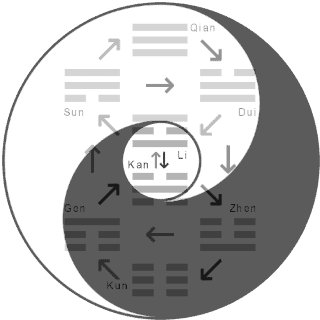
Let’s remember what we know about yin and yang – the pair of opposites which is classically explained with the following examples:
| Yin | Yang |
| dark | bright |
| empty | full |
| cold | hot |
| inside | outside |
In this sense, we could now complement this dichotomy with the following Western concepts:
| Yin | Yang |
| Self and self-relation | Ego and world-relation |
| individual | society |
| psyche and lived body | objectified body |
| “I-entirely-with-me” | “I-in-the-world” |
Self-Relation and World-Relation
The development that is represented by a hexagram can thus also be understood as a winding path meandering between the opposing poles of “I-entirely-with-me” (self and self-relation; dark area of the graphic) and “I-in-the-world” (world-relation; white area of the graphic).
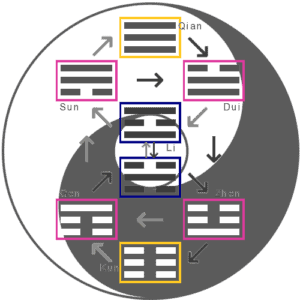
Thereby, the various positions that the trigrams take within the yin-yang symbol are qualitatively different. They vary from calm-stable over dynamic-moving to dynamic-tilting:
- Quiet points, calm-stable: pure yin (Kun – marked yellow – self relation) and pure yang (Qian – marked yellow – world relation).
- Landmark points, dynamic-moving: trigrams built from different types of lines, with distinct dynamics (Zhen, Gen, Sun, Dui – marked pink)
- Test points, dynamic-tilting: likewise trigrams which are built from different types of lines, however with a less clear dynamic and/or with a tilting tendency (trigrams Kan and Li – marked dark blue)
Yin and Yang
Let us return to the concept of yin and yang and consider it in relation to the Western model of self-relation and world-relation.
Yang: World Relation
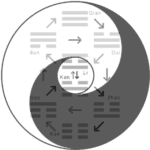
In this model Yang, the bright, hot, shown as a light area in the symbolic representation to the left, refers to the individual’s encounter with the world. The assigned trigrams are Qian, Dui, Li and Sun, with Qian being the most calm and stable trigram, Li the most precarious.
This field is concerned with issues of differentiation, with the boundary between the individual and its environment. For as long as this boundary is incomplete or fragile, the individual is not individuated either. It does not exist as an independent being in the world, but is instead an undifferentiated, amalgamated part of it.
Yin: Self Relation
In similar manner, in this model Yin, the dark, cold, can be understood as the individual’s encounter with himself. The assigned trigrams are Kun, Gen, Kan and Zhen, with Kun being the most calm, stable, Kan the most unstable and precarious character.
The realm of Yin is about inner wholeness, about integrating and appropriating what exists within oneself. It is about engaging with one’s own inner being and making peace with oneself.
Quiet Points, Landmarks, Test Points
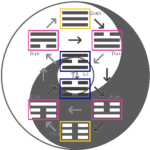
Individual trigrams are color-coded within the yin-yang symbol according to their qualitative dynamics.
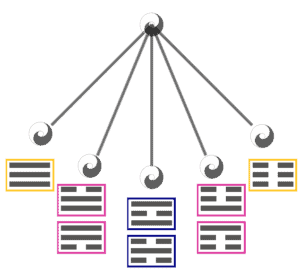
If we imagine the movement of the Dao like a pendulum movement, different energetic states result depending on where in its course the pendulum is located:
- at the quiet points the pendulum seems to stand still for a moment: Kun and Qian (both marked yellow),
- at the landmark points the pendulum moves dynamically, the direction is clear, the momentum increases: Zhen, Gen, Sun, Dui (marked pink),
- test points are tipping points, where the pendulum abruptly changes direction. Downward movement becomes upward movement and vice versa, or, in this interpretive model, the focus changes from self-relation to world-relation and vice versa. The corresponding trigrams are Kan and Li (marked dark blue).
Quiet Points: Qian and Kun
The two quiet points are the trigrams Qian, the heaven, (pure Yang, yellow) and Kun, the earth, (pure Yin, yellow). Both consist of identical lines, thus exclusively of (solid) Yang lines and (broken) Yin lines, respectively.
In Qian the encounter with the world reaches completion in the sense that one knows about one’s own self-efficacy in the world: I know that I am an individual separate from the environment – and as such, I do have an impact on my surrounding environment.
In Kun, the individual completely becomes one – one with himself – and has found peace within himself by integrating conscious and (formerly) repressed parts which now become a valuable source.
Landmark Points: Sun, Dui, Zhen, Gen
The four landmark points (pink) represent a kind of commotion that creates positive momentum.
In case of the trigrams Dui, the lake, and Gen, the mountain, momentum is created by adding a line opposite to the preceding character to its top. Both characters open up to the (respective other) sphere and allow themselves to be touched – by inner (Gen) or outer (Dui) impulses – even if this initially may appear to be threatening.
In Zhen, the thunder, and Sun, the wind / tree, on the other hand, the precarious momentum of the previous sign takes now a clear direction: towards inner (Zhen) or outer impulses (Sun) impulses.
Test Points: Li and Kan
The trigrams Li, the fire, and Kan, the water, are dynamic characters as well. But here the momentum is abrupt, dangerous, difficult to control.
Yin and Yang here have the tendency to merge abruptly, to somehow tip over. This is why in this model Li and Kan are being referred to as test points (dark blue): At these points we can see how far the two areas – inner integration and dealing with the outer world – have already developed and matured.
The Journey is the Reward
So what is the development aiming at, what is the goal of the path outlined by the I Ching? Or, put differently: Is it desirable to always receive pure yin or pure yang as the answer to a question? Has one then achieved it?
Yes and no. Of course it makes sense to know about one’s own self-efficacy within the world and to act self-efficaciously in it. Just as it is important to have achieved an integrated, peaceful wholeness within oneself and to rest in it.
But life is alive and constantly testing us. The goal of the journey is by no means to escape from the world and its trials, but rather the opposite: to be present in the world and courageously face it with all its challenges. In this sense, the goal of the path – and its reward – is to master the path itself in the best possible way: with a certain resilience that, despite all challenges, always finds its way back to a peaceful mood – in both worlds, inner and outer.
And in this sense questioning the I Ching can be a quite meaningful aid. Because it shows us in which areas of our existence new learning experiences are waiting for us.


